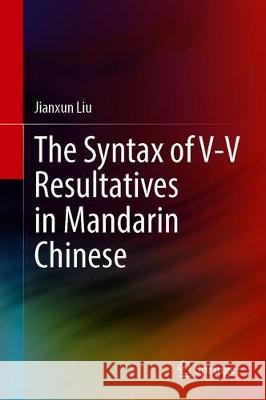The Syntax of V-V Resultatives in Mandarin Chinese » książka
topmenu



The Syntax of V-V Resultatives in Mandarin Chinese
ISBN-13: 9789813368453 / Angielski / Twarda / 2021 / 125 str.
The Syntax of V-V Resultatives in Mandarin Chinese
ISBN-13: 9789813368453 / Angielski / Twarda / 2021 / 125 str.
cena 301,89
(netto: 287,51 VAT: 5%)
Najniższa cena z 30 dni: 289,13
(netto: 287,51 VAT: 5%)
Najniższa cena z 30 dni: 289,13
Termin realizacji zamówienia:
ok. 22 dni roboczych
Dostawa w 2026 r.
ok. 22 dni roboczych
Dostawa w 2026 r.
Darmowa dostawa!
Kategorie:
Kategorie BISAC:
Wydawca:
Springer
Język:
Angielski
ISBN-13:
9789813368453
Rok wydania:
2021
Wydanie:
2021
Ilość stron:
125
Waga:
0.37 kg
Wymiary:
23.39 x 15.6 x 0.97
Oprawa:
Twarda
Wolumenów:
01
Dodatkowe informacje:
Wydanie ilustrowane
Chapter 1: Introduction
1 The empirical domain and basic research questions
2 Arguments and proposals: Preview
2.1 The generation of V-V resultative compounds
2.2 The syntactic structure of V-V resultatives
2.3 The alternation properties of V-V resultatives 3 Theoretical assumptions
4 Outline of the dissertation
Chapter 2: The generation of resultative V-V compounds
1 Introduction
2 Lexicalist vs. syntactic approaches to word formation 2.1 The lexicalist approach
2.2 Word formation in Distributed Morphology: A syntactic approach
3 The inner vs. outer domain hypothesis for the formation of complex words
3.1 The inner vs. outer domain hypothesis
3.2 The crosslinguistic application of the two-domain hypothesis
4 A lexicalist analysis: Y. Li (2005)
5 Generation of resultative and parallel V-V compounds in Mandarin
5.1 Resultative vs. parallel V-V compounds
5.1.1 Parallel V-V compounds
5.1.2 Contrasting properties of resultative and parallel V-V compounds
5.2 An analysis under the two-domain hypothesis
5.2.1 Semantics: Compositionality vs. idiosyncrasy
5.2.2 Nominalizations
5.2.3 Free vs. bound component morphemes
5.2.4 Productivity vs. semi-productivity
5.2.5 Adverbial modification
6 Conclusion
Chapter 3: The syntactic structure of Mandarin V-V resultatives: An event-mapping
approach 1 Introduction
2 The event-mapping approach to argument structure
2.1 Lexicalist vs. syntactic approaches to argument structure
2.1.1 The lexicalist approach
2.1.2 The syntactic approach: The autonomy of syntactic structure
2.2 The event-mapping approach to argument structure
2.2.1 Event-structure decomposition of verbal semantics
2.2.2 The event-mapping approach to argument structure
2.2.2.1 Travis (2010) and Ramchand (2008)
2.2.2.2 Lin (2004)
2.2.2.3 Marantz (2013)
2.2.3 Assumptions of my analysis
3 Previous studies of V-V resultatives in Mandarin
3.1 Weakly decompositional analyses of Mandarin V-V resultatives
3.2 Lin (2004): An event-mapping approach
4 Syntactic structure of V-V resultatives in Mandarin: The evidence from adverbial
modification properties
4.1 The syntactic structure of object-oriented V-V resultatives
4.1.1 The evidence for the vCAUSEP
4.1.2 The evidence for the vBECOMEP
4.1.3 The absence of vBEP
4.1.4 An intermediate summary
4.2 The syntactic structure of subject-oriented V-V resultatives
4.2.1 Adverbial modification properties of subject-oriented V-V resultatives 4.2.1.1 V1: Unavailable for adverbial modification
4.2.1.2 Adverbial modification of V2
4.2.1.3 The impossibility of state-modifying adverbs
4.2.2 Subject-oriented V-V resultatives with surface object
5 Conclusion
Chapter 4: The external argument and alternations of V-V resultatives
1 Introduction
2 The properties of the subject of V-V resultatives
2.1 Theoretical background: The different structures of causatives and noncausatives
2.1.1 Pylkkänen (2008): Causatives and noncausatives differ in
appearance/absence of vCAUSE
2.1.2 Alexiadou, Anagnostopoulou & Schäfer (2015): Causatives and noncausatives differ in the appearance/absence of Voice.
2.2 The properties of the subject of resultatives
2.2.1 The external argument in object-oriented resultatives
2.2.2 Subject-oriented resultatives: The absence of an external argument
3 The alternation of resultative V-V compounds
3.1 The de-causativization of object-oriented V-V resultative compounds
3.2 The causativization of subject-oriented resultative V-V compounds
3.2.1 Summary of the proposal
3.2.2 Direct Causation Condition: Rappaport Hovav & Levin (2012)
3.2.3 The alternation properties of subject-oriented V-V resultatives:
My analysis
4 Conclusion
Chapter 5: Concluding Remarks
1 The present work: Brief summary and its significance
2 Future studies
References
Jianxun Liu received his Ph.D. in linguistics from the University of Victoria Canada in 2019. Liu’s primary research areas are generative syntactic theory, the semantics/syntax interface, and the syntax of Chinese. Liu’s research particularly focuses on the two generative theories, Minimalist Program and Distributed Morphology, and their application in the study of Mandarin Chinese. Liu was awarded a doctoral fellowship by the Social and Humanities Research Council of Canada in 2016.
This book addresses the three fundamental properties of V-V resultative constructions in Mandarin Chinese: their generation, their syntactic structure, and their alternations. This book is original and new in the following aspects. First, adopting the ‘inner vs. outer domain’ theory, it provides new analysis and evidence that these compounds are generated in syntax, not in lexicon. Second, this book argues that the two subclasses of V-V resultative constructions, object-oriented vs. subject-oriented V-V resultatives, actually have different structures. Their syntactic contrasts have not been observed in the literature before. Third, this book is new in determining the syntactic structure of the V-V resultative constructions through their adverbial modification properties. It demonstrates that the previous isomorphism analysis of the syntactic structure of Chinese V-V resultatives does not hold. Finally, this book provides a new analysis of the issue of the alternations of V-V resultatives. In contrast to previous analyses, which generally view the causative alternation as the idiosyncratic property of particular V-V compounds, this book provides a principled analysis.
This book makes a substantial improvement of the current understanding of the issues in the syntax of Mandarin Chinese and gives new support to certain theories of the generative grammar from the perspective of Mandarin Chinese.
1997-2025 DolnySlask.com Agencja Internetowa
Zobacz: Księgarnia Czeska | Wydawnictwo Książkowe Klimaty | Mapa strony | Lista autorów
KrainaKsiazek.PL - Księgarnia Internetowa
KrainaKsiazek.PL - Księgarnia Internetowa









